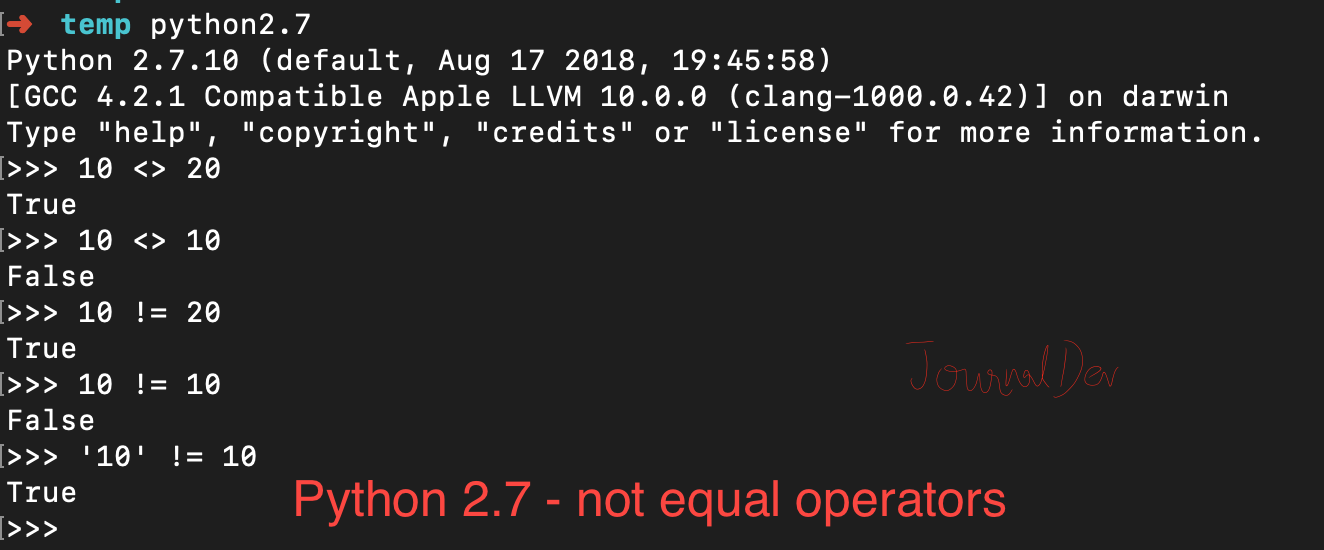פעולת האופרטור "לא שווה" ב-Python מחזירה True אם שתי המשתנים הם מאותו סוג ויש להם ערכים שונים, אם הערכים זהים אז היא מחזירה False. Python היא שפת תכנות דינמית ובעלת סוגים חזקים, כך שאם שני המשתנים יש להם את אותם ערכים אך הם מסוגים שונים, אז אופרטור "לא שווה" יחזיר True.
אופרטורי "לא שווה" ב-Python
| Operator | Description |
|---|---|
| != | Not Equal operator, works in both Python 2 and Python 3. |
| <> | Not equal operator in Python 2, deprecated in Python 3. |
דוגמה ב-Python 2
בואו נראה כמה דוגמאות לאופרטור "לא שווה" ב-Python 2.7.
$ python2.7
Python 2.7.10 (default, Aug 17 2018, 19:45:58)
[GCC 4.2.1 Compatible Apple LLVM 10.0.0 (clang-1000.0.42)] on darwin
Type "help", "copyright", "credits" or "license" for more information.
>>> 10 <> 20
True
>>> 10 <> 10
False
>>> 10 != 20
True
>>> 10 != 10
False
>>> '10' != 10
True
>>>

דוגמה ב-Python 3
כאן יש כמה דוגמאות עם מסוף Python 3.
$ python3.7
Python 3.7.0 (v3.7.0:1bf9cc5093, Jun 26 2018, 23:26:24)
[Clang 6.0 (clang-600.0.57)] on darwin
Type "help", "copyright", "credits" or "license" for more information.
>>> 10 <> 20
File "<stdin>", line 1
10 <> 20
^
SyntaxError: invalid syntax
>>> 10 != 20
True
>>> 10 != 10
False
>>> '10' != 10
True
>>>
 ניתן להשתמש באופרטור "לא שווה" ב-Python גם עם f-strings אם אתה משתמש בגרסה 3.6 או גרסה גבוהה יותר.
ניתן להשתמש באופרטור "לא שווה" ב-Python גם עם f-strings אם אתה משתמש בגרסה 3.6 או גרסה גבוהה יותר.
x = 10
y = 10
z = 20
print(f'x is not equal to y = {x!=y}')
flag = x != z
print(f'x is not equal to z = {flag}')
# python is strongly typed language
s = '10'
print(f'x is not equal to s = {x!=s}')
פלט:
x is not equal to y = False
x is not equal to z = True
x is not equal to s = True
פייתון לא שווה עם אובייקט מותאם אישית
כאשר אנו משתמשים באופרטור לא שווה, זה קורא לפונקציה __ne__(self, other). לכן אנו יכולים להגדיר את המימוש המותאם אישית שלנו עבור אובייקט ולשנות את הפלט הטבעי. נניח שיש לנו מחלקת Data עם שדות – id ו-record. כאשר אנו משתמשים באופרטור לא-שווה, אנו רוצים פשוט להשוות אותו לערך של record. אנו יכולים להשיג זאת על ידי המימוש שלנו של פונקצית __ne__().
class Data:
id = 0
record = ''
def __init__(self, i, s):
self.id = i
self.record = s
def __ne__(self, other):
# יחזיר נכון אם סוגים שונים
if type(other) != type(self):
return True
if self.record != other.record:
return True
else:
return False
d1 = Data(1, 'Java')
d2 = Data(2, 'Java')
d3 = Data(3, 'Python')
print(d1 != d2)
print(d2 != d3)
פלט:
False
True
שים לב שערכי הרשומה של d1 ו-d2 זהים אך "id" שונה. אם נסיר את הפונקציה __ne__(), אז הפלט יהיה כזה:
True
True
באפשרותך לבדוק את התסריט המלא של פייתון ועוד דוגמאות בפייתון מה-מאגר ה-GitHub שלנו.
Source:
https://www.digitalocean.com/community/tutorials/python-not-equal-operator













